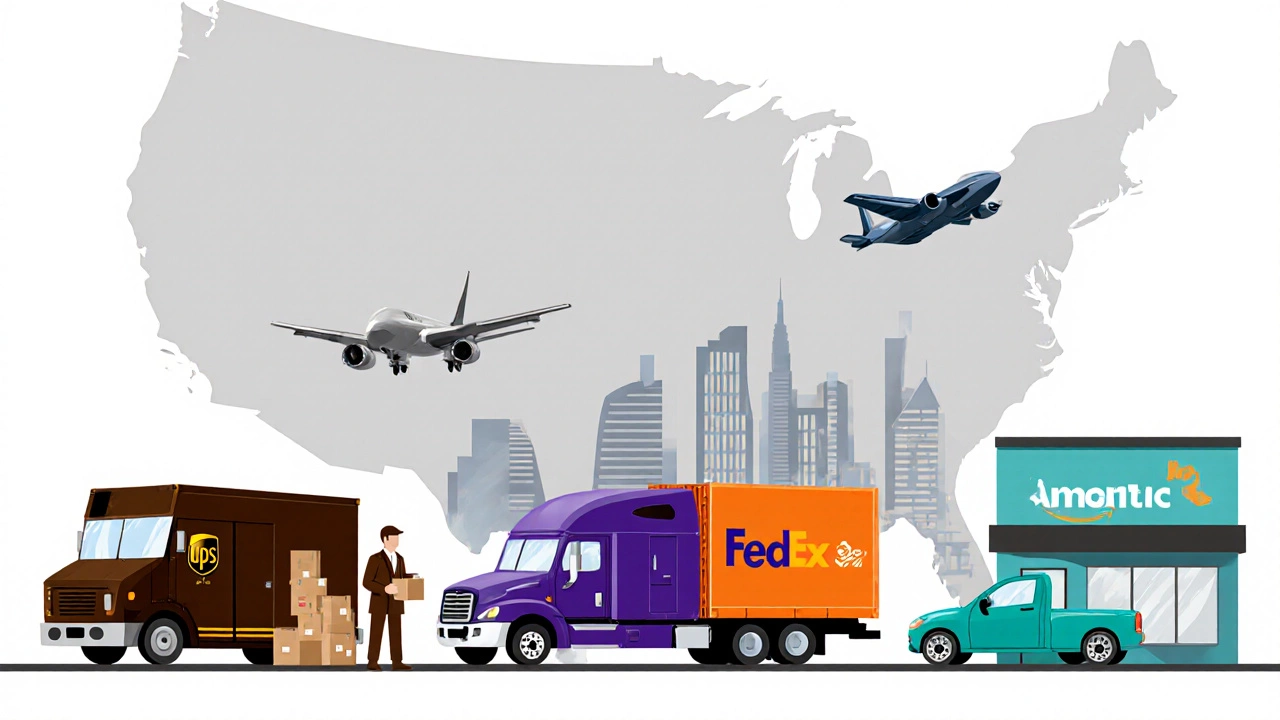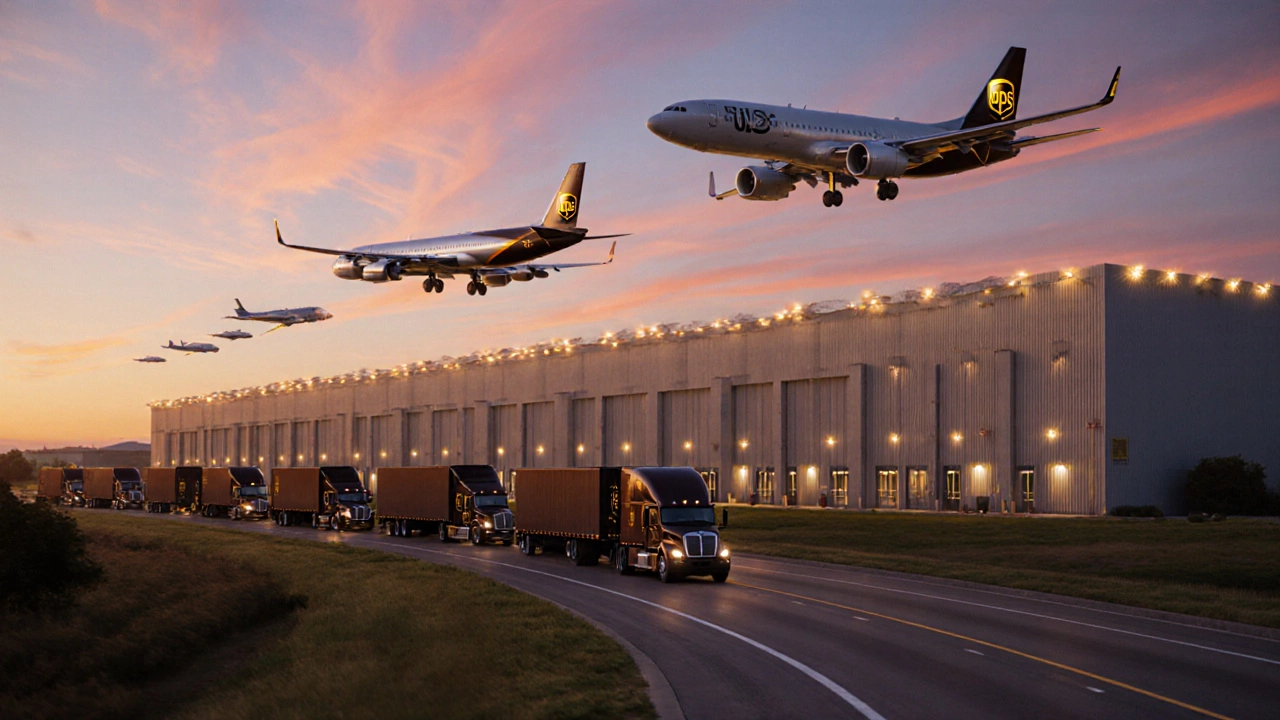Logistics Company Comparison Tool
Revenue
Total sales from package delivery, freight, and supply-chain services
Fleet Size
Number of trucks, planes, and delivery vans that move goods
Employee Headcount
People who operate the network, from drivers to IT staff
Volume
Packages or tonnage moved in a year
Top U.S. Logistics Companies (2024)
| Company | Revenue (US$ B) | Employees | Fleet Size (Vehicles) | Annual Packages/Volume |
|---|---|---|---|---|
| UPS | 91.0 | 540,000 | 120,000+ | 5.7 B packages |
| FedEx | 89.5 | 480,000 | 115,000+ | 5.3 B packages |
| XPO Logistics | 9.9 | 45,000 | 30,000 | - (freight tonnage) |
| J.B. Hunt | 9.1 | 31,000 | 28,000 | - (freight tonnage) |
| Amazon Logistics | - (integrated) | ~150,000 | ~70,000 vans & aircraft | 1.2 B packages |
Leaderboard Ranking
- Fleet Size: 120,000+ vehicles
- Employees: 540,000
- Volume: 5.7 B packages
- Fleet Size: 115,000+ vehicles
- Employees: 480,000
- Volume: 5.3 B packages
Key Insights
- UPS Dominance: UPS holds the largest market share with $91.0 billion in revenue and over 120,000 vehicles.
- FedEx Close Behind: FedEx trails with $89.5 billion revenue and a slightly smaller fleet.
- Freight Leaders: XPO Logistics and J.B. Hunt dominate freight-forwarding with combined revenues under $10 billion.
- Amazon's Role: Amazon Logistics handles 1.2 billion packages annually but does not report separate logistics revenue.
- Market Growth: The U.S. logistics market grew at an average of 4.5% from 2020 to 2024.
When you think about parcels zooming across the country, massive warehouses humming at night, and a fleet that never sleeps, one name usually pops up first. That name is United Parcel Service (UPS), and it’s the biggest logistics company in the US by most industry metrics. But why does UPS hold that crown, and how does it stack up against rivals like FedEx, XPO Logistics, or Amazon Logistics? Below you’ll find a step‑by‑step breakdown that answers those questions, plus a quick snapshot you can bookmark for later.
Key Takeaways
- UPS leads the U.S. logistics market with 2024 revenue of $91.0billion, a fleet of over 120,000 vehicles, and more than 540,000 employees.
- FedEx trails closely with $89.5billion revenue and a slightly smaller parcel volume.
- XPO Logistics and J.B. Hunt dominate the freight‑forwarding niche, but their total revenues are under $10billion each.
- Market share in 2024: UPS 24%, FedEx 23%, Amazon Logistics 12%, others share the remaining 41%.
- Future growth will hinge on automation, green‑fleet initiatives, and expanding e‑commerce partnerships.
How We Define “Biggest”
There’s no single number that tells the whole story. In the logistics world analysts usually look at four key pillars:
- Revenue - total sales from package delivery, freight, and supply‑chain services.
- Fleet size - number of trucks, planes, and delivery vans that can move goods.
- Employee headcount - people who operate the network, from drivers to IT staff.
- Volume - packages or tonnage moved in a year.
Because each pillar tells a slightly different story, we rank companies based on a weighted score (40% revenue, 30% fleet, 20% employees, 10% volume). UPS tops the list in three of the four categories and wins the overall composite score.
United Parcel Service (UPS)
United Parcel Service is a multinational package delivery and supply‑chain management company headquartered in Atlanta, Georgia. Founded in 1907, UPS operates the world’s largest integrated air‑ground network, delivering more than 5.7billion packages per year. In 2024 the company reported $91.0billion in revenue, employed 540,000 people, and maintained a fleet of 120,000+ vehicles, including 600+ aircraft. Its “brown‑coat” drivers are instantly recognizable, but the real power lies in the technology hub that optimizes routes in real time, cutting fuel use by up to 12%.

Who Challenges UPS?
The logistics landscape is crowded, but a handful of competitors consistently chase the top spot. Here’s a quick look at the most relevant rivals.
FedEx Corporation is a global courier delivery services company based in Memphis, Tennessee. FedEx operates the world’s second‑largest freight network, handling everything from overnight parcels to heavyweight freight. In 2024 FedEx generated $89.5billion in revenue, employed 480,000 staff, and owned a fleet of about 115,000 vehicles and 680 aircraft.
XPO Logistics is a North‑American transportation and logistics provider headquartered in Greenwich, Connecticut. XPO focuses on contract logistics, last‑mile delivery, and truckload brokerage. XPO posted $9.9billion in revenue and runs roughly 30,000 trucks across the United States.
J.B. Hunt Transport Services is a leading supply‑chain solutions provider based in Lowell, Arkansas. J.B. Hunt combines intermodal, dedicated contract, and truckload services for large shippers. Its 2024 revenue stood at $9.1billion, with a fleet of about 28,000 tractor‑trailers.
Amazon Logistics is the delivery arm of e‑commerce giant Amazon, operating out of Seattle, Washington. Amazon Logistics handles last‑mile deliveries for Prime orders and operates a growing network of delivery vans and aircraft. While Amazon does not publish a separate revenue line, its logistics arm moved an estimated 1.2billion packages in 2024, capturing roughly 12% of the U.S. parcel market.
Comparison Table: Top U.S. Logistics Companies (2024)
| Company | Revenue (US$ B) | Employees | Fleet Size (Vehicles) | Annual Packages/Volume |
|---|---|---|---|---|
| UPS | 91.0 | 540,000 | 120,000+ | 5.7B packages |
| FedEx | 89.5 | 480,000 | 115,000+ | 5.3B packages |
| XPO Logistics | 9.9 | 45,000 | 30,000 | - (freight tonnage) |
| J.B. Hunt | 9.1 | 31,000 | 28,000 | - (freight tonnage) |
| Amazon Logistics | - (integrated) | ~150,000 (logistics staff) | ~70,000 vans & aircraft | 1.2B packages |
Why UPS Remains On Top
Several strategic moves keep UPS ahead of the pack:
- Integrated Air‑Ground Network: Owning a fleet of over 600 aircraft means UPS can control critical bottlenecks, especially during peak seasons.
- Technology Investments: The ORION routing algorithm saves up to 10 million gallons of fuel annually and reduces driver overtime.
- Diversified Services: Beyond parcel delivery, UPS offers freight forwarding, customs brokerage, and supply‑chain consulting, spreading risk across multiple revenue streams.
- Green Initiatives: UPS aims to have 25% of its fleet electric by 2030, attracting environmentally conscious shippers.
- Strategic Acquisitions: Recent purchases of small‑parcel startups in the Midwest have expanded its same‑day network without costly rebuilds.
These factors translate into higher margins and a broader moat than most rivals.

Market Share Trends (2020‑2024)
The U.S. logistics market grew at an average annual rate of 4.5% from 2020 to 2024, driven by e‑commerce surges and reshoring of manufacturing. UPS’s market share rose from 22% in 2020 to 24% in 2024, while FedEx held steady around 23%. Amazon Logistics entered the top‑five in 2022, eroding a small slice of UPS’s parcel volume but also prompting UPS to partner on “last‑mile” deliveries in several metro areas.
Freight‑only players like XPO and J.B. Hunt saw modest double‑digit growth in truckload volumes, but their overall share of the total logistics market remains under 10% because the parcel segment dominates U.S. revenues.
Future Outlook: What Could Shift the Leaderboard?
While UPS looks secure for now, a few forces could reshape the hierarchy:
- Automation & Robotics: Companies that master autonomous trucks or warehouse robots could cut labor costs dramatically.
- Regulatory Changes: New emissions standards may favor firms that have already electrified their fleets.
- Consolidation: A major merger between two mid‑size carriers could create a new challenger with enough scale to dent UPS’s margins.
- Data‑Driven Networks: If Amazon opens its logistics data platform to third parties, smaller shippers might bypass traditional carriers.
For now, UPS’s blend of scale, technology, and diversified services keeps it at the summit.
Quick Checklist: Verifying the Biggest Logistics Company
- Check latest annual reports for revenue figures (UPS > $90B in 2024).
- Confirm fleet size via company disclosures or FAA filings (UPS > 120k vehicles, 600+ aircraft).
- Look at employee counts in SEC filings (UPS ~540k).
- Cross‑reference package volume data from industry analysts like Armstrong & Associates.
Frequently Asked Questions
Which company has the largest revenue in U.S. logistics?
United Parcel Service (UPS) reported $91.0billion in revenue for 2024, making it the highest‑earning logistics firm in the United States.
How does UPS’s fleet compare to FedEx’s?
UPS operates about 120,000+ ground vehicles and over 600 aircraft, while FedEx runs roughly 115,000 vehicles and 680 aircraft. Both networks are global, but UPS’s ground fleet is slightly larger.
Is Amazon Logistics bigger than UPS?
Amazon Logistics moves more than a billion packages a year, but because its logistics costs are bundled within Amazon’s overall revenue, it does not report a separate logistics revenue figure comparable to UPS’s $91billion. By revenue, UPS remains larger.
What are the main metrics used to rank logistics companies?
Analysts typically weigh revenue, fleet size, employee count, and volume of parcels or freight moved. Some also consider market share, technology adoption, and sustainability initiatives.
How is UPS preparing for a greener future?
UPS has pledged to make 25% of its delivery fleet electric by 2030, invests in alternative‑fuel trucks, and runs a carbon‑offset program that supports reforestation projects worldwide.





